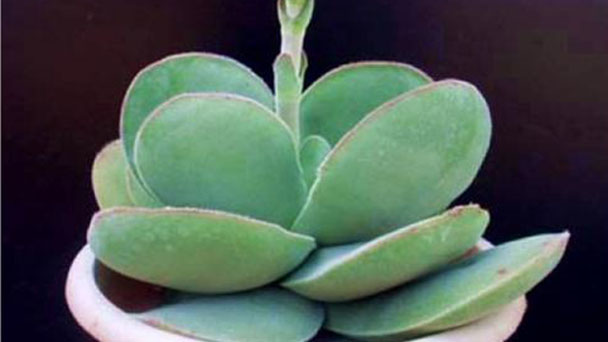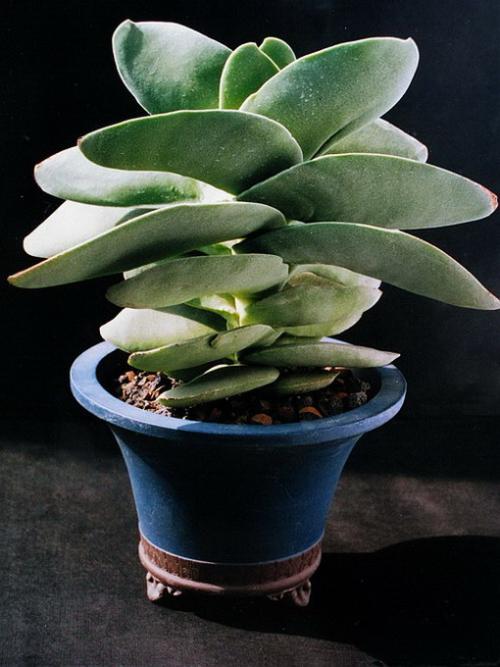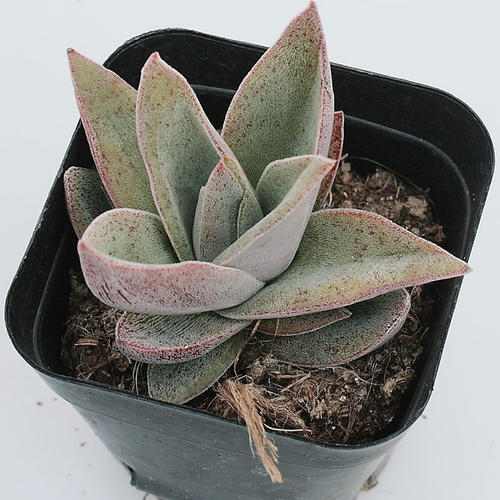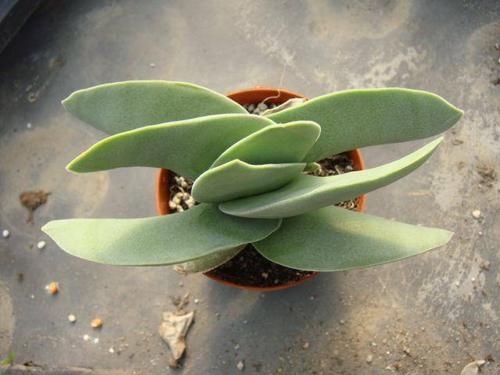Crassula Falcata (Propeller Plant) profile
Written by Maggie
Oct 30 2021

Crassula Falcata, also called propeller plant, is a succulent plant of Crassulaceae and Crassula. Crassula Falcata is a perennial herb, native to eastern South Africa, grows in its native place as a semi-shrub.
Crassula Falcata Picture

Characteristics of Crassula Falcata
Crassula Falcata (propeller plant) height is 50 ~ 100 cm. Plant height can reach more than 1 meter. Leaves are simple alternate, sickle - shaped, fleshy, leaves faintly pinkish. Inflorescences are terminal in cymes cymose; The floret is orange red. Fruit follicles ellipsoid. The leaves of crassula falcata (propeller plant) are thick and juicy, grayish green, without a petiole, and grow symmetrically close to the stem in a very neat arrangement. The leaves at the base are small and grow larger as they go up. The Crassula Falcata shape is very strange, like a piece of sharp knife. Crassula Falcata (propeller plant) usually blooms at the turn of summer or fall, orange or bright red, and consists of numerous clusters of small flowers. The flowers last for a long time, up to a month.
Habits of Crassula Falcata
Crassula Falcata is native to eastern South Africa. Crassula Falcata prefers warm, dry and semi-cloudy environments. Crassula Falcata has strong negative resistance. Dry early, afraid of water, avoid strong light. The suitable temperature for growth is 15-25 ℃, and the temperature in winter is not less than 10℃. Crassula Falcata prefers fertile, loose and well drained sandy loam. The requirement is fertile loose, permeability good sandy loam.
In summer, Crassula Falcata basically shades the sun and cuts off water. Spring and autumn are the growing season, it can be full sunshine, growing moisture is dry and watered thoroughly, the flower friend that cannot grasp can be dry for a long time. Crassula Falcata can tolerate minus 3 degrees in the winter, so keep the soil dry. Propeller plant is also remarkably resistant to drought, having been mummified after being without water all summer. The temperature drops slightly to be able to indomitable flowering again. Crassula Falcata is resistant to moisture and drought, so once you know her habits, she's easy to keep. Crassula Falcata, who doesn't normally look pretty, is in stunning bloom for a long time.
Propagation of Crassula Falcata
Propagation can be used side - bud cuttings, cuttings. Crassula Falcata is often propagated by cutting and sowing seeds. Cuttage, choose to enrich, tall and straight leaves, often cut a short stem, slightly dry after inserted in the sand bed, about 15-20 days can take root. The leaves can also be cut into 5-6 cm long blocks, after the incision is dry, flat on the wet sand surface, about 20-30 days from the healing place to root, grow new branches. Sowing, in the spring, sowing about 10-15 days germination, seedling growth faster.

How to Grow and Care for Crassula Falcata
Crassula Falcata Soil Care
The soil for Crassula Falcata can be selected peat soil, sand and slag according to the ratio of 2∶1∶1 mixed, the surface of the basin soil adds a layer of ceramsite, in case the base leaves contact the soil caused by decay, once found rotten phenomenon, should take out the base leaves, and air dry the wound or in the wound coated with sulfur powder.
Crassula Falcata Watering
Crassula Falcata needs sufficient moisture to keep the soil moist during the growing season. Even in summer and winter, the soil should not be kept dry for a long time. Because the roots of Crassula Falcata are very thin, it is difficult to recover the absorption function in case of drought, which causes the leaves to lose water and become soft, and in severe cases, the plant will die.
Crassula Falcata Fertilizing
Fertilizing 1 times a month, using diluted cake fertilizer water or 15-15-30 potted flower special slow-release fertilizer.
Crassula Falcata Pruning
If Crassula Falcata (propeller plant) grows too high, support or core cutting should be set to lower the plant shape, and the cuttings should be used for propagation. If the stem and leaves of Crassula Falcata are found to fall off or the plant cannot stand upright during conservation, the upper part of the Crassula Falcata should be cut and cut together with the leaves. In this way, the surviving plant will grow stronger and more ornamental. The mother plant after the truncation will give birth to many young plants, which can be used for propagation.
Crassula Falcata Temperature Care
Crassula Falcata dormancy caused by high temperature in summer should be placed in a cool and ventilated place; Winter temperature is not less than 5℃ can be safe wintering.
Adequate moisture should be ensured during the growing season and the soil should be kept moist. Even in summer and winter, the soil should not be kept dry for a long time. Because the roots of Crassula Falcata (propeller plant) are very thin, it is difficult to recover the absorption function in case of drought, resulting in the loss of water and softening of the leaves, and in severe cases, the plant will die.
In addition, if found stem leaves fall off in the maintenance process, or Crassula Falcata can not stand up, should be the upper part of the Crassula Falcata together with the leaves cut cuttings, so that the Crassula Falcata after the survival of robust growth, more ornamental, and the mother plant after the head will grass many young plants, can be used to breed.
Disease of Crassula Falcata
Crassula Falcata (propeller plant) mainly harms fleksy leaves with grey mold. At the initial stage of occurrence, it is sprayed with 500 times liquid of 50% methyl tobutine wetting powder. Indoor ventilation is not smooth, there will be whitefly harm, with 50% kill borer pine emulsion 1500 times the fluid spray kill.
Crassula Falcata Uses
Crassula Falcata (propeller plant) plants decorate a windowsill, desk or end table in an inviting, verdant and elegant way. In Nanwan, the layout in the steps, vestibule velvet small garden corner corner, beautiful eye-striking.

Latest Updated
- Benefits of Bugleweed - 7 Science-backed Health Benefits
- Bugleweed Dangers & Side Effects - Is It Poisonous?
- How to Plant Evergreen Trees - What You Should Know
- When to Plant Evergreens - Grow Guide for Evergreen Trees
- 12 Wonderful Evergreen Shrubs for Your Garden
- 12 Popular Evergreen Plants with Pictures for Beginners
- When And How To Prune A Lilac Bush Like a Pro
- How to Grow & Care for Lilac Vine (Hardenbergia Violacea)
- Japanese Lilac Tree (Syringa Reticulata) Care & Propagation Guide
- Shumard Oak Pros and Cons - What to Know
Popular Articles
- Winter maintenance of Antirrhinum Majus
- How to Grow Terminalia Mantaly Tree
- How to Grow and Care for Crossostephium Chinense
- How to grow Antirrhinum Majus in spring
- Peristeria Elata (Dove Orchid) Profile: Info & Care Guide
- Underwatered Snake Plant (Sansevieria Trifasciata) - Signs And How To Fix
- How to Care for Brazilian Jasmine Plant (Mandevilla Sanderi)
- How to Grow & Care for Graptopetalum Purple Delight in Summer
- Rosa Chinensis (China Rose): Plant Growing & Care Tips
- How to Care for Baby Sun Rose (Aptenia Cordifolia)